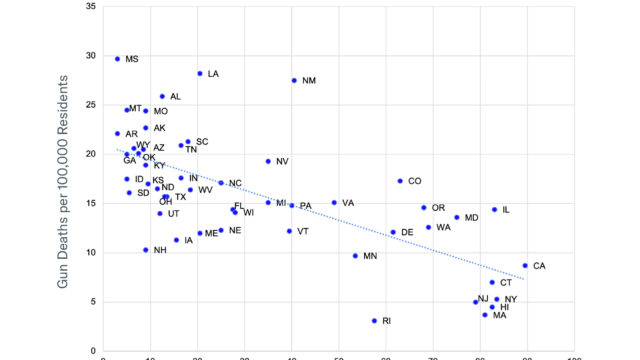Repeal Shoot First Laws
Repeal Shoot First Laws
What does this solve?
Shoot First, also known as Stand Your Ground, laws allow a person to shoot and kill another person in a public area even when there are clear and safe ways to retreat from a dangerous situation. These laws threaten public safety by encouraging armed vigilantism.
Shoot First laws encourage avoidable escalation of violence, and they do not deter crime. Under traditional self-defense law, a person can use force to defend themselves anywhere. If they’re outside their home, though, they can’t use force that is likely to kill or seriously injure someone if there’s a safe way to avoid it. These laws give people a license to shoot and kill in public, even if they started the confrontation and even when they can safely walk away from the danger. Shoot First laws are associated with increases in gun deaths1Michelle Degli Esposti et al., “Analysis of ‘Stand Your Ground’ Self-Defense Laws and Statewide Rates of Homicides and Firearm Homicides,” JAMA Network Open 5, no. 2 (February 21, 2022): e220077, https://doi.org/10.1001/jamanetworkopen.2022.0077; Marc Levy et al., “Stand Your Ground: Policy and Trends in Firearm-Related Justifiable Homicide and Homicide in the US,” Journal of the American College of Surgeons 230, no. 1 (2020): 161-167.e4, https://doi.org/10.1016/j.jamcollsurg.2019.11.003; Abdul Munasib, Genti Kostandini, and Jeffrey L. Jordan, “Impact of the Stand Your Ground Law on Gun Deaths: Evidence of a Rural Urban Dichotomy,” European Journal of Law and Economics 45, no. 3 (June 2018): 527–54, https://doi.org/10.1007/s10657-018-9581-z; Cassandra Crifasi et al., “Correction to: Association Between Firearm Laws and Homicide in Urban Counties,” Journal of Urban Health 95, no. 5 (October 15, 2018): 773–76, https://doi.org/10.1007/s11524-018-0306-y; Cassandra K. Crifasi et al., “Association Between Firearm Laws and Homicide in Urban Counties,” Journal of Urban Health 95, no. 3 (2018): 383–90, https://doi.org/10.1007/s11524-018-0273-3; David K. Humphreys, Antonio Gasparrini, and Douglas J. Wiebe, “Evaluating the Impact of Florida’s ‘Stand Your Ground’ Self-Defense Law on Homicide and Suicide by Firearm: An Interrupted Time Series Study,” JAMA Internal Medicine 177, no. 1 (January 2017): 44–50, https://doi.org/10.1001/jamainternmed.2016.6811; David K. Humphreys, Antonio Gasparrini, and Douglas J. Wiebe, “Association Between Enactment of a ‘Stand Your Ground’ Self-Defense Law and Unlawful Homicides in Florida,” JAMA Internal Medicine 177, no. 10 (October 2017): 1523–24, https://doi.org/10.1001/jamainternmed.2017.3433; Benjamin Ukert, Douglas J. Wiebe, and David K. Humphreys, “Regional Differences in the Impact of the ‘Stand Your Ground’ Law in Florida,” Preventive Medicine 115 (October 2018): 68–75, https://doi.org/10.1016/j.ypmed.2018.08.010; Michelle Degli Esposti et al., “Increasing Adolescent Firearm Homicides and Racial Disparities Following Florida’s ‘Stand Your Ground’ Self-Defence Law,” Injury Prevention, December 20, 2019, https://doi.org/10.1136/injuryprev-2019-043530. and injuries,2Chandler McClellan and Erdal Tekin, “Stand Your Ground Laws, Homicides, and Injuries,” Journal of Human Resources 52, no. 3 (2017): 621–53, https://doi.org/10.3368/jhr.52.3.0613-5723R2; Justin Lee et al., “Guns and States: Pediatric Firearm Injury,” Journal of Trauma and Acute Care Surgery 75, no. 1 (July 2013): 50–53, https://doi.org/10.1097/TA.0b013e3182999b7a. and disproportionately impact communities of color.3Everytown Research analysis of FBI Supplementary Homicide Report, 2014 to 2018; John Roman, “Race, Justifiable Homicide, and Stand Your Ground Laws: Analysis of FBI Supplementary Homicide Report Data” (Urban Institute, July 2013), https://urbn.is/3mHnU1E; Nicole Ackermann et al., “Race, Law, and Health: Examination of ‘Stand Your Ground’ and Defendant Convictions in Florida,” Social Science & Medicine 142 (2015): 194–201, https://doi.org/10.1016/j.socscimed.2015.08.012. Lawmakers should put the safety of their constituents first and repeal these dangerous laws in their states.
Which states have rejected Shoot First laws?
21 states have rejected this policy
No Shoot First Law
Alabama has not rejected this policy
No Shoot First Law
Alaska has not rejected this policy
No Shoot First Law
Arizona has not rejected this policy
No Shoot First Law
Arkansas has not rejected this policy
No Shoot First Law
California has rejected this policy
No Shoot First Law
Colorado has rejected this policy
No Shoot First Law
Connecticut has rejected this policy
No Shoot First Law
Delaware has rejected this policy
No Shoot First Law
Florida has not rejected this policy
No Shoot First Law
Georgia has not rejected this policy
No Shoot First Law
Hawaii has rejected this policy
No Shoot First Law
Idaho has not rejected this policy
No Shoot First Law
Illinois has rejected this policy
No Shoot First Law
Indiana has not rejected this policy
No Shoot First Law
Iowa has not rejected this policy
No Shoot First Law
Kansas has not rejected this policy
No Shoot First Law
Kentucky has not rejected this policy
No Shoot First Law
Louisiana has not rejected this policy
No Shoot First Law
Maine has rejected this policy
No Shoot First Law
Maryland has rejected this policy
No Shoot First Law
Massachusetts has rejected this policy
No Shoot First Law
Michigan has not rejected this policy
No Shoot First Law
Minnesota has rejected this policy
No Shoot First Law
Mississippi has not rejected this policy
No Shoot First Law
Missouri has not rejected this policy
No Shoot First Law
Montana has not rejected this policy
No Shoot First Law
Nebraska has rejected this policy
No Shoot First Law
Nevada has not rejected this policy
No Shoot First Law
New Hampshire has not rejected this policy
No Shoot First Law
New Jersey has rejected this policy
No Shoot First Law
New Mexico has rejected this policy
No Shoot First Law
New York has rejected this policy
No Shoot First Law
North Carolina has not rejected this policy
No Shoot First Law
North Dakota has not rejected this policy
No Shoot First Law
Ohio has not rejected this policy
No Shoot First Law
Oklahoma has not rejected this policy
No Shoot First Law
Oregon has rejected this policy
No Shoot First Law
Pennsylvania has not rejected this policy
No Shoot First Law
Rhode Island has rejected this policy
No Shoot First Law
South Carolina has not rejected this policy
No Shoot First Law
South Dakota has not rejected this policy
No Shoot First Law
Tennessee has not rejected this policy
No Shoot First Law
Texas has not rejected this policy
No Shoot First Law
Utah has not rejected this policy
No Shoot First Law
Vermont has rejected this policy
No Shoot First Law
Virginia has rejected this policy
No Shoot First Law
Washington has rejected this policy
No Shoot First Law
West Virginia has rejected this policy
No Shoot First Law
Wisconsin has rejected this policy
No Shoot First Law
Wyoming has not rejected this policy
How it Works
Shoot First laws encourage escalated violence.
Traditional self-defense law gives people the right to protect themselves, but also recognizes that it is always best to avoid killing someone if possible. It does not require a person to retreat from a situation if retreating would put them in danger, but requires a person to avoid killing another if there is a clear and safe way to do so. Shoot First laws distort the public perception of lawful self-defense and encourage people to shoot first and ask questions later.
Shoot First laws are associated with increases in firearm homicide and overall homicide rates resulting in 700 additional deaths each year.1Michelle Degli Esposti et al., “Analysis of ‘Stand Your Ground’ Self-Defense Laws and Statewide Rates of Homicides and Firearm Homicides,” JAMA Network Open 5, no. 2 (February 21, 2022): e220077, https://doi.org/10.1001/jamanetworkopen.2022.0077. At the state level, these laws have been associated with considerable increases in gun deaths, including unintentional deaths: 6 to 7 percent more gun deaths occurred in suburban counties2Abdul Munasib, Genti Kostandini, and Jeffrey L. Jordan, “Impact of the Stand Your Ground Law on Gun Deaths: Evidence of a Rural Urban Dichotomy,” European Journal of Law and Economics 45, no. 3 (June 2018): 527–54, https://doi.org/10.1007/s10657-018-9581-z. and 8 percent more gun deaths occurred in urban counties in states that adopted these laws.3Cassandra Crifasi et al., “Correction to: Association Between Firearm Laws and Homicide in Urban Counties,” Journal of Urban Health 95, no. 5 (October 15, 2018): 773–76, https://doi.org/10.1007/s11524-018-0306-y; Cassandra K. Crifasi et al., “Association Between Firearm Laws and Homicide in Urban Counties,” Journal of Urban Health 95, no. 3 (2018): 383–90, https://doi.org/10.1007/s11524-018-0273-3.
Shoot First laws disproportionately impact communities of color.4Everytown analysis of FBI Supplementary Homicide Report, 2014 to 2018; John Roman, “Race, Justifiable Homicide, and Stand Your Ground Laws: Analysis of FBI Supplementary Homicide Report Data” (Urban Institute, July 2013), https://urbn.is/3mHnU1E; Nicole Ackermann et al., “Race, Law, and Health: Examination of ‘Stand Your Ground’ and Defendant Convictions in Florida,” Social Science & Medicine 142 (2015): 194–201, https://doi.org/10.1016/j.socscimed.2015.08.012. In states with these laws, homicides in which white shooters kill Black victims are deemed justifiable five times more frequently than when the situation is reversed.5Everytown Research analysis of FBI Supplementary Homicide Report, 2014 to 2018.
By the numbers
5x
In states with Shoot First laws, homicides in which white shooters kill Black victims are deemed justifiable five times more frequently than when the situation is reversed.
32%
The implementation of Florida’s Shoot First law was associated with a 32 percent increase in monthly firearm homicide rates.
23–45%
Florida’s Shoot First law was associated with a 45 percent increase in monthly firearm homicide rates among white residents and a 23 percent increase among Black residents.
3 in 5
Roughly three out of every five people in Florida claiming Shoot First had prior arrests before killing someone and invoking the law, with about one-third of these defendants having previously been arrested for serious crimes like assault and robbery.
Myth & Fact
Myth
Shoot first laws are necessary to prevent harm.
Fact
None of the research on these laws has found it to prevent violent crime.1Rosanna Smart et al., “Stand-Your-Ground Laws,” in The Science of Gun Policy: A Critical Synthesis of Research Evidence on the Effects of Gun Policies in the United States, Second Edition (RAND Corporation, 2020), 235–50, http://www.rand.org/t/RR2088-1; RAND Corporation, “The Effects of Stand-Your-Ground Laws,” April 22, 2020, https://bit.ly/3ay1a1y; RAND Corporation, “Gun Policy Research Review,” Gun Policy in America, accessed December 11, 2020, https://bit.ly/3mEwq1w. In fact, in most cases, you can avoid a conflict when one party retreats. For example, in the majority of Florida Shoot First cases, the person who invoked the law could have safely retreated to avoid the confrontation.2Chris Davis, “Florida’s Stand Your Ground Law,” Tampa Bay Times, June 3, 2012, https://bit.ly/3c1KZub.
All Resources
Repeal Shoot First Laws
All Resources
New Data, Same Conclusion: Smart Gun Laws Save Lives
Everytown's Gun Law Rankings show a clear correlation between states with strong gun laws and lower rates of gun violence.
Everytown Research & Policy
Road Rage Shootings Are Continuing to Surge
Reports of road rage shootings have increased significantly during the pandemic. With easy access to guns, road rage can turn deadly.
Everytown Research & PolicyThe Dangers of Shooting First: “Stand Your Ground” Laws Are a License to Kill
For centuries, self-defense laws have given people the right to protect themselves. Shoot First laws, also known as Stand Your Ground laws, go beyond these…
Report
Disarm Hate: the Deadly Intersection of Guns and Hate-Motivated Violence
Easy access to firearms gives a hate-filled individual the means to shatter numerous lives and whole communities.
Fact Sheet
